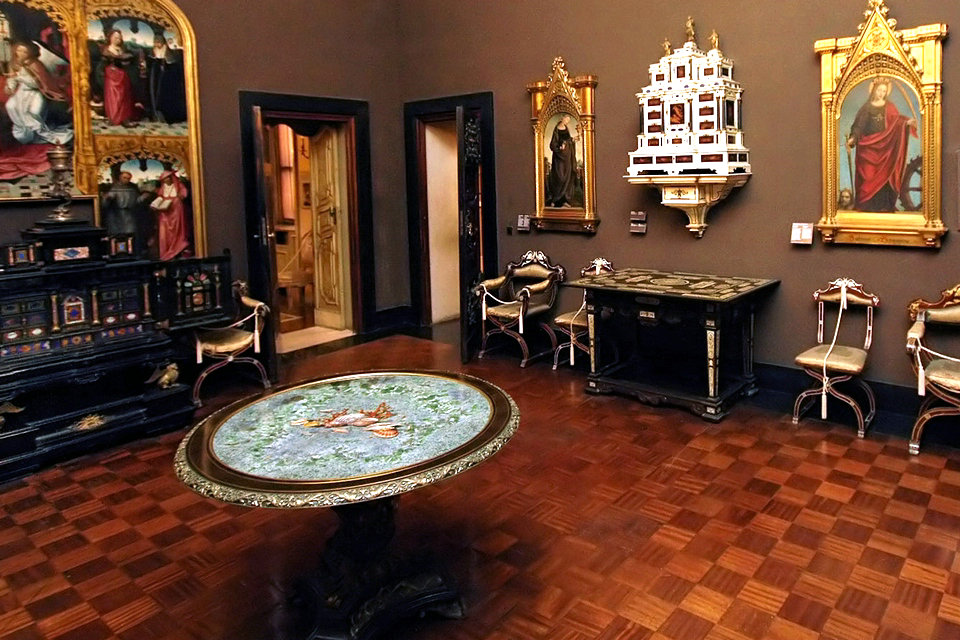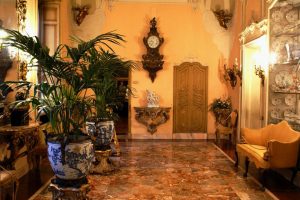The decorations of the room were inspired by the style of the ‘Northern Renaissance’, which also had the function of a living room.
The rooms were conceived as containers for a series of ancient works of art and designed to accommodate paintings and furnishings, more like a modern art gallery, than a real house marked by a private and personal dimension.
Black room
The Black Room is one of the historical rooms of the Museum, originally the living room of Gian Giacomo Poldi Pezzoli’s apartment. Inspired by the Northern Renaissance style, evoked by the large Flemish polyptych exposed on the wall, it continued to be called the Black Room despite the destruction of the very fine ebony cladding. Fortunately, the furniture and doors survived the bombing, designed by Giuseppe Bertini and made by the crew and craftsmen Giuseppe Speluzzi, Luigi Barzaghi and Pietro Zaneletti.
The room was conceived by Luigi Scrosati and Giuseppe Bertini by 1855 as a treasure chest in which to set the large Flemish polyptych. The decorations of the room were inspired by the style of the ‘Northern Renaissance’, which also had the function of a living room. It was also called the black room for the ebony cladding of the walls and ceiling, unfortunately destroyed in 1943.
The doors and the refined furniture (tables, chairs), specially designed by Giuseppe Bertini and made by Giuseppe Speluzzi, Luigi Barzaghi and Pietro Zaneletti between 1855 and 1880.
Murano Glass Room
The room was the bedroom of Gian Giacomo Poldi Pezzoli and houses both the collection of archaeological objects and the collection of Murano glass, about two hundred pieces purchased largely by Gian Giacomo himself and initially kept in the Dante Study. The Sala dei Vetri in Murano was seriously damaged by the bombings of ’43: the lacunar ceiling, the frieze frescoed by Luigi Scrosati and the fireplace , also by Scrosati, were lost . The beautiful doors carved by Giuseppe Ripamonti and some furnishings were saved.
The room was made between 1846 and 1856 by the neo-baroque carver Giuseppe Ripamonti. The bombings of 1943 destroyed the lacunar ceiling, the frieze frescoed by Luigi Scrosati, the fireplace, the boiseries and the canopy bed. The beautiful carved doors have been saved.
Dante study
This collected environment, which can be accessed from the Murano Glass Room, formerly the bedroom of Gian Giacomo Poldi Pezzoli, was the collector’s small private studio. It is one of the most fascinating spaces of the Museum, the only and precious example left of the original wall decoration. The Studiolo Dantesco, designed by Giuseppe Bertini together with Luigi Scrosati, is one of the first European testimonies of historicist revival. The mural paintings , the furnishings and the windows are inspired by Dante’s Middle Ages. The small room, where Poldi Pezzoli had already collected the most precious works of his Wuderkammer, houses some original furnishings of the house.
This room was the small private studio of Gian Giacomo Poldi Pezzoli. Designed by Giuseppe Bertini and Luigi Scrosati, set up between 1853 and 1856, it is the only precious example left of the painted decoration of the house.
The environment is inspired by the Middle Ages and Dante, depicted in the frescoes and stained glass windows of Bertini himself. In this room Gian Giacomo Poldi Pezzoli kept the most precious works of his collections of applied arts.
Trivulzio room
In the Trivulzio room some 17th century paintings by Italian artists are exhibited as well as some furnishings from different eras. The showcase with archaeological weapons is a historical reference to the previous intended use of the room.
Palma room
The historic Sala del Palma is the main access to the Trivulzio room, which Gian Giacomo Poldi Pezzoli had chosen as the privileged location for his collection of ancient weapons, which are now exhibited in the new Armory on the ground floor. The room houses a painting by Palma il Vecchio and the precious collection of solar clocks by the architect Piero Portaluppi: over two hundred pieces that arrived in the Museum in 1978, five years after the substantial donation of mechanical watches from the Falck collection on display in the Sala degli Orologi.
Hall of Golds
The Sala degli Ori is set up where once was the private toilet of Gian Giacomo Poldi Pezzoli, furnished with the newest and most luxurious equipment of the time and completely rebuilt after the war. The showcases house the museum’s goldsmith’s collection, over two hundred pieces grouped in four sections: antique enamels, sacred goldsmith’s, collectibles and jewels, among which a group of Etruscan pieces from tombstones stands out .
Room of the eighteenth century Veneto
The Sala del Settecento Veneto, together with the Sala del Perugino and the Sala dei Trecenteschi, housed most of the paintings by Gian Giacomo Poldi Pezzoli. Historically known as the First Painted Room, today it houses the works of Canaletto, Rosalba Carriera, Francesco Guardi and Giovanni Battista Tiepolo.
Perugino room
The Sala del Perugino, together with the Sala del Settecento Veneto and the Sala dei Trecenteschi, housed much of the collection of paintings by Gian Giacomo Poldi Pezzoli. Historically known as the Second Painted Room, the Room takes its current name from a painting believed to be an autograph work by Perugino in the past and later attributed to the artist’s workshop.
Room of the fourteenth century
The Sala dei Trecenteschi, together with the Sala del Settecento Veneto and the Sala del Perugino, housed much of the collection of paintings by Gian Giacomo Poldi Pezzoli. Historically known as Terza Sala a Quadri and formerly Saletta dei Veneti, it brings together the works painted between the fourteenth and fifteenth centuries with the technique of the gold background.
Pollaiolo terrace
The covered terrace is a place of great charm precisely because it strongly retains its value as an open space thanks to the transparent roof and the presence of the red facades of the historic building, both inside and outside the windows. The main feature of this space is its multifunctionality: Museum visitors can take a break during their visit, but brunches, aperitifs, events, meetings and educational activities can also be made in this place.
Poldi Pezzoli Museum
Open to the public in 1881, beloved by both the Milanese and the international public, the Poldi Pezzoli Museum enchants not only for the charm of the rooms, which evoke the eras of the past from the Middle Ages to the eighteenth century up to the Armory reinterpreted by the contemporary artist Arnaldo Pomodoro, but also for the variety and richness of the collections. Masterpieces of painting, sculptures, rugs, lace and embroidery, weapons and armor, jewelery, porcelain, glass, furniture, solar and mechanical watches: over 5000 extraordinary objects, from antiquity to the nineteenth century, immersed in a magical atmosphere.
In the heart of Milan, created thanks to the passion of the noble art collector Gian Giacomo Poldi Pezzoli (1822-1879), the Poldi Pezzoli Museum is one of the most important and famous house-museums in the world. It is next to the Scala theatre, in the street once called “corsia del Giardino” (garden). Actually, behind the severe Neoclassical façade of the palace there is still a beautiful garden.
The house-museum, beloved by the Milanese and international public, opened in 1881; it fascinates not only for the charm of the rooms, evoking the past (from medieval times to the 18th century up to the Armoury by the contemporary artist Arnaldo Pomodoro), but also for the variety and richness of its collections. Masterpieces of painting, sculptures, carpets, lace and embroidery, arms and armour, jewels, porcelain, glass, furniture, clocks: over 5000 pieces from Antiquity to the 19th century suspended in a magical atmosphere that evokes the one chosen by the great Milanese art collector.
The museum It is part of the circuit of “Case Museo di Milano” and exhibits works by numerous artists, including: Perugino, Piero della Francesca, Sandro Botticelli, Antonio Pollaiolo, Giovanni Bellini, Michelangelo Buonarroti, Pinturicchio, Filippo Lippi, Andrea Mantegna, Jacopo Palma il Vecchio, Francesco Hayez, Giovanni Battista Tiepolo, Alessandro Magnasco, Jusepe de Ribera, Canaletto, Lucas Cranach the Elder, Luca Giordano.





